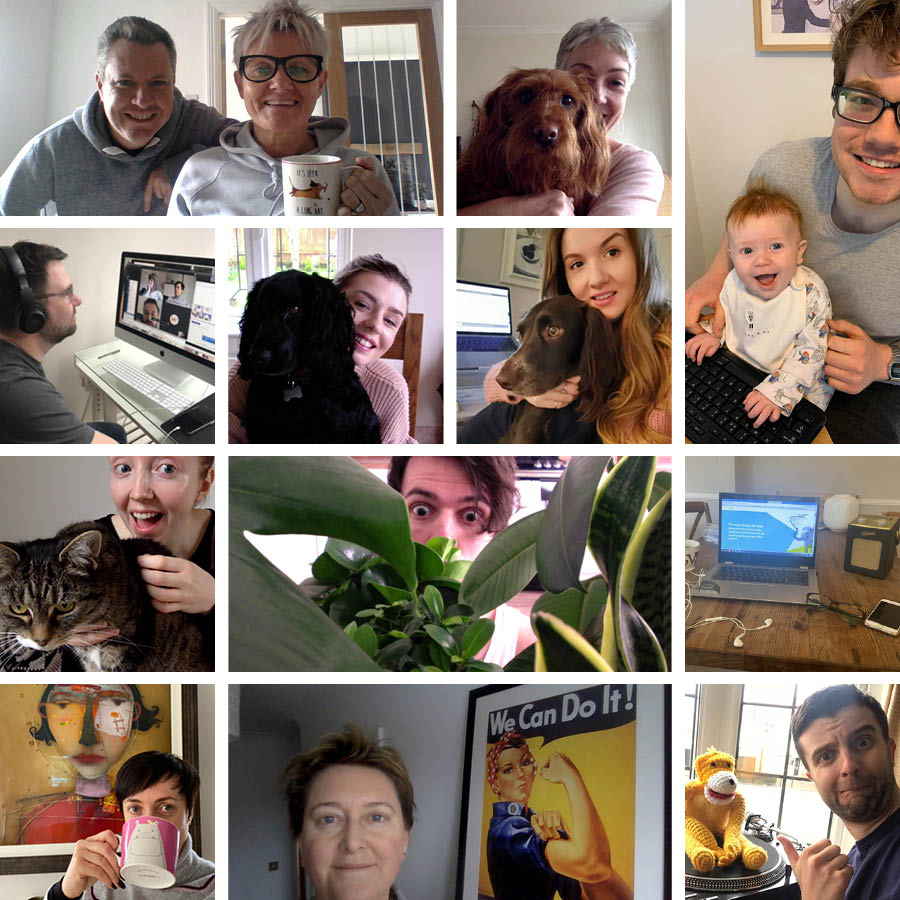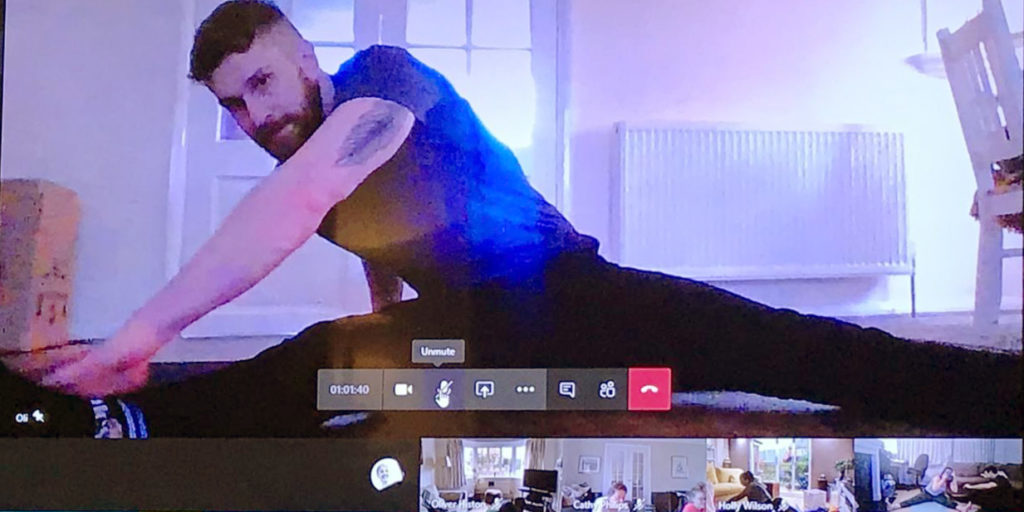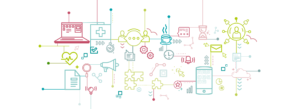Reading this blog, we’d bet a healthy sum that, like us, you’re one of the millions of people who have suddenly found yourself working from home full-time as your organisation plays its part in preventing the spread of COVID-19.
As the novel Coronavirus spreads swiftly across the globe, panic is on the up, toilet rolls are flying off the shelves, and increasing numbers of people are being advised to keep a safe distance away from others and enter a prolonged period of self-isolation.
Just months ago, many of us couldn’t have predicted the challenges we’ve suddenly found ourselves grappling with. And it’s had a profound effect on how we’re going about our personal and professional lives.
But whilst working away from the office is clearly not a new thing – until now, remote working on such a widespread and prolonged scale has only ever been the stuff of science fiction.
So to have it arrive on your door step completely out of the blue, might have come as a bit of a shock to the system.
There’s already plenty of advice out there on how to make the transition to remote working as seamless as possible.
But now that working out of the office has become the new norm, you’re probably wondering: what can organisations and employees do to ensure collective engagement, communication, and productivity over the long-term – as well as staving off the negative effects of isolation?
Physical isolation vs social isolation
Before we explore our working from home tips to keep engagement and productivity up while working remotely, it’s helpful to break down the two types of isolation that you’ll find yourself experiencing through a workplace lens: physical isolation and social isolation.
As your organisation has adopted a remote-working contingency plan, it’s likely that you’ll have lots of steps in place to help you stay connected to your teams and work effectively from home.
You might be opting for the usual suspects of email and phone calls – or perhaps you’ve pushed the boat out and are making the most of apps like Microsoft Teams or Slack.
HR policies have likely been updated to cover the unexpected change in circumstances and keep everyone in the know.
And you’ve likely taken it upon yourself to create an effective impromptu office space, complete with laptop, paperwork and copious amounts of homemade coffee (check out how our team have transformed their living room, bedroom and dining room spaces into their own personal home offices below!).

But while these measures might solve the problem of physical isolation – that is, being geographically separated from the rest of your colleagues – they won’t necessarily keep engagement and motivation riding high.
Especially since ‘Relationships with colleagues’ was ranked as the sixth most important factor to workplace wellbeing in our recent research.
Which puts it right up there alongside factors like salary, health and safety, and job security – things that are generally accepted to be high up on the list.
And so it makes sense to address this factor during a crisis. Because social isolation doesn’t just impact on people’s mental health. It can also have a knock-on effect on people’s physical health too – increasing risks of heart disease, weakening immune systems, and even leading to feelings of physical pain.
You might not be committing yourself to total isolation, but it’s important to consider your own and your wider team’s health and wellbeing in these unprecedented times.
So ensuring employees continue to benefit from the wellbeing boost that colleague relationships provide will need to be actively managed by leaders and managers – to provide opportunities for people to connect and interact in the same way they would in the office.
Like us, you’ll know that engagement is a two-way street. Just as organisations must put the right systems and processes in place – it’s up to you to find ways to keep you and your teams motivated and fulfilled too.
In short – it requires a balanced approach.
So what can you do to make your organisation’s remote working experience as indistinguishable as possible from your usual day-to-day in the office?
Take a delve into our working from home tips below for some helpful handpicked ideas to keep your engagement and wellbeing on a high…
5 working from home tips to keep social isolation at bay during the Coronavirus crisis
1. Take advantage of video conferencing instead of texts or phone calls
Many of us have been using video conferencing to connect with remote workers in our organisations for a good few years now.
But overnight, it’s taken a whole new level of significance.
When we’re in the workplace and can strike up a conversation with a colleague in-person at the drop of a hat, using an instant-messenger app such as Yammer, Slack or Microsoft Teams can often be a quickfire way to touch base without having to get up from your desk.
But now that our interaction with colleagues is entirely digital, the lack of face-to-face connection that comes with these tools might suddenly feel very isolating. The same goes for catching up over the phone. It’s easy and convenient – but reinforces the disconnect between you, and the folks at the other end.
Unlike these methods of communicating with colleagues, video conferencing breaks down these barriers by being a more true-to-form recreation of an in-person conversation.
Why video conferencing is more effective at mitigating social isolation
If you’re an internal comms professional, you won’t need us to tell you why video conferencing is the most effective form of digital communication. Tons of research has been done that shines a light on why face-to-face interaction is the best way to get messages and ideas to stick.
But its capacity to bring people together on a deeper level also makes it a great way to stave off the effects of extended periods of solitude.
In fact, research suggests video conferencing is up to 80% as effective at building bonds and creating connections as genuine in-person interaction.
This is much higher than phone and email conversations.
And face-to-face communication has been proven to spark mirror neurons in the brain, influencing us to reflect and replicate the body language of the person we’re talking to. Therefore strengthening rapport, and deepening emotional engagement.
But in a more personal, conversational context, video conferencing is so effective because it enables us to fully share in the interactive experience.
We can read and respond to body language, visual cues and tone in a way which simply isn’t possible through other methods of communication.
Which means we miss out on the majority of information being transferred when we don’t interact in-person.
So ditch the mobile and the instant-messaging app, and make a habit of firing up the webcam for your catch-ups and meetings instead.
Which leads us nicely onto…
2. Replace in-person engagement activities with virtual ones
You’re probably used to partaking in regular social activities with your colleagues such as team lunches or group wellness sessions.
Here at H&H, our weekly Pilates sessions, monthly Lunch and Learns and regular agency gatherings have proved really valuable when it comes to strengthening our relationships and spirt as a team.
Now that everyone’s working from home however, it might seem that these activities will have to be put on the backburner.
But who said they could only be done offline?
Finding ways to keep up the camaraderie and keep work fun and interactive is essential for maintaining a sense of culture and connectedness.
For instance, we like this neat little tool, Kudoboard. It allows you to recognise others with personalised group e-cards signed by colleagues so that everyone can share in the celebration of a personal special occasion such as a Birthday or work anniversary. A great way to keep remote teams connected by sharing shout-outs everyone will remember!
Creating a coordinated programme of engagement to balance both the physical and social barriers that come from remote working is a great way to ensure commitment and consistency in maintaining colleague connections.
Some if utilising these working from home tips, why not:
Hold wellness sessions online
Check out this screenshot from our online Pilates session this week with our instructor Ollie which our H&H regulars dialled into!

Take part in virtual social activities
As well as our virtual Pilates sessions, our Cathy will also now be hosting a weekly Friday ‘pub quiz’ – where we’ll all get together over our webcams for a spot of quizzing and a tipple or two.

Or try something more light-hearted and playful
For instance, you may have seen the news about the Coronavirus choir making the rounds recently as a way to bring together people feeling cut off due to self-isolation. Why not try something similar with your colleagues over webcam? (Just remember that it might not be everybody’s cup of tea).
As we said earlier, video conferencing is an ideal platform for maintain connections because it provides a realistic imitation of real life.
So consider keeping up any social activities you do with your team, by hosting them over webcam.
After all, the experience of work in the office isn’t all work and no play.
So why should it be any different outside the workplace?
3. Be creative with your online meetings
We’ve already talked about how you can make the experience of working fro home more engaging for you and your colleagues through virtual social activities.
But what about when it comes to the group meetings that take up so much of our time in the workplace?
We always recommend making all meetings as fun and engaging as possible – whether that’s through incorporating gamification, encouraging group participation, or utilising interesting and inventive materials to bring the content to life.
But of course, the issue with remote working is that it’s pretty hard to physically interact over a video conference beyond generic small talk and normal conversation.
So, build in interactivity in other ways.
Hold a short quiz or survey
If you’re sharing an idea you want to generate insightful debate on, why not consider holding a short quiz or survey so attendants can share their opinions and get involved more directly in the discussion? (Even if it’s just for a bit of fun).
We created a nifty little tool called Push to help you create quickfire polls to get people engaged – check it out here for free!
Encourage people to get creative
Or you could get people to draw illustrations or mind maps as an alternative to simply asking them what they think. Not only is this more creatively engaging and great for encouraging people to think outside the box, but it also enables visual and kinaesthetic learners to explore their ideas in a more accessible and unusual way.
Use storytelling to make meetings more engaging
Or taking the idea of getting visually creative further – why not invite people to articulate their opinions and ideas through the medium of storytelling, to inspire innovative thinking and bring fresh perspectives to light?
Our creatively versatile Storytelling Cards are designed to help you do this.
A visual feast for the eyes, you can use them as part of a fun icebreaker activity, to explore a situation or experience through a personal lens, or to communicate a complex idea in a unique and relatable way.

Get your pack here and see what you can discover!
There are plenty of ways to inject energy and interaction into your virtual meetings to bridge the divide between those in attendance.
So use it as an opportunity for some creative flair – and bring everyone closer together in the process!
4. Create regular opportunities for interaction
Interaction doesn’t just come from organised group get-togethers or team meetings. It also comes from the small things, such as quick check-ins from line managers or impromptu conversations by the water cooler.
In the virtual world, these can be replicated through online forums and social networking platforms.
This is key to keeping people connected, and ensuring those who feel isolated and anxious about the current situation feel empowered to talk about their concerns openly.
These tools can provide regular opportunities for ‘pop up’ conversations.
Use hashtags to encourage debate around particular topics.
You could create your own specific to your business, but you could also take inspiration from these more general ones making the rounds on Twitter and LinkedIn at the moment:
#WorkingFromHomeLife
#WorkingFromHome
#RemoteWorking
#HomeWorking
Start a private chat
If you’re feeling unsure, confused or lonely, start a private chat with a colleague or your line manager to share your concerns.
Use online groups to spark discussion
Or create groups in apps like Slack or Microsoft Teams where the whole team can post messages, share content and invite discussion to generate meaningful conversation and encourage connection.
To help everyone stay positive, make sure to share upbeat and inspiring stories about people’s remote working experiences. Or at the very least, as you saw in our photo earlier – invite colleagues to share amusing photos of their little helpers to spread the positive vibes!
5. Use social activities to break your state
When you’re living and working in the same place, it’s very easy for the lines to be blurred and for work and home life to blend into one.
This can make it difficult to focus your mind and get ‘in the zone’, as well as making it harder to switch off at the end of the day.
So just as your daily commute to and from the office acts as a consistent buffer between your professional and personal life, try to establish some sort of a buffer when working remotely too.
This might include, for instance, a quick walk around the block just before starting work or right after downing your tools can make a world of difference. Even a fleeting smile with a stranger can help you feel more connected to the outside world.
Research suggests you’re nearly 100% more likely to think creatively when walking rather than sitting.
And so why wouldn’t you use it as an excuse to get the brain – and the heart – pumping? These simple working from home tips can help you make a habit of taking regular breaks.
Spread out your conversations
Scheduling your online meetings so they don’t all come at once will help to break up your desk time so you have opportunities to embrace a rejuvenating change of scenery.
Avoid succumbing to presenteeism
Being out of sight from all your colleagues means they can’t see when you’re working. So remote working can sometimes drive an unhealthy desire to be ‘always on’, in order to avoid creating the impression that you’re not pulling your weight.
But this is completely counterintuitive to maximising your productivity. It will only work to increase stress, and make you fall prey to burnout faster.
So another of these working from home tips is to remember that it’s okay to take regular short breaks – and use this time to kick back on social media, enjoy a healthy snack, or spend some quality time with your little ones.
In other words – treat it as an opportunity, not a chore!
Breaking state is a useful way to stay productive, avoid burnout and establishing clear and healthy boundaries between work and personal life.
So remember to do it regularly. Schedule it in your calendar if you have to! And you’ll likely find your energy and performance stay shipshape, despite the change in scenery.
It’s very likely that the Coronavirus crisis won’t be going away anytime soon.
But while we may find ourselves adapting to this sudden and radical change, if you put these working from home tips into practice to ease the transition, maintain connections and encourage frequent interaction amongst your team – you should find yourself taking remote working totally in your stride.
Good communication is critical too.
In our latest research report, we unveil for the very first time the link between internal communication and employee engagement and wellbeing. Download your copy today to see for yourself how good communication can help your team stay happy, healthy and motivated during the time of COVID-19.
And feel free to get in touch if you’d like some expert advice and working from home tips to optimise remote working for your team and the bottom line.
We’re specialists in building communication and engagement programmes that get results and inspire action whatever the challenge – so strike up a conversation with us at talktous@handhcomms.co.uk to hear it from the horses’ mouths!








